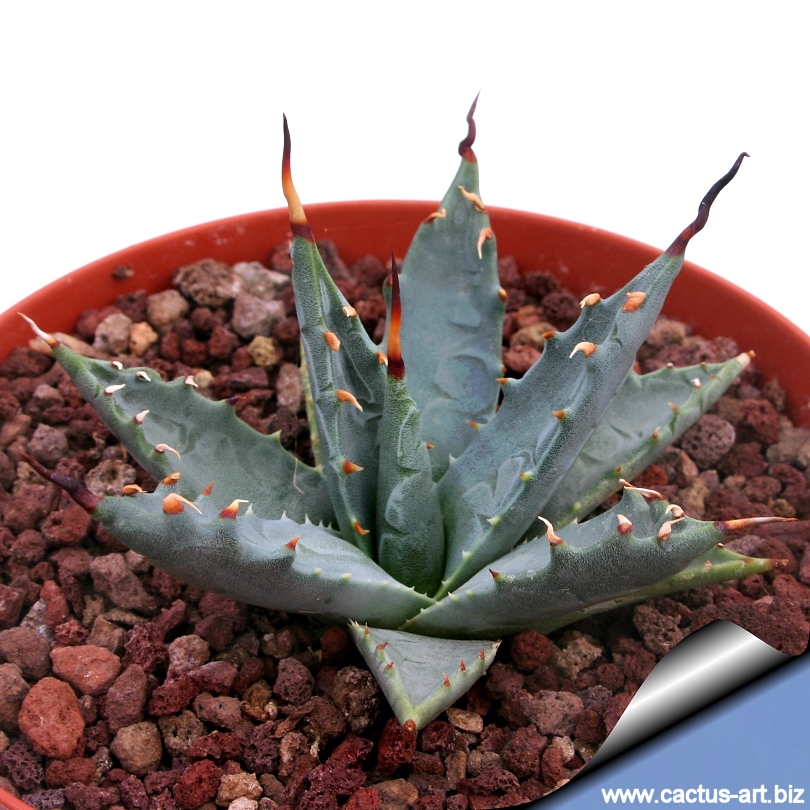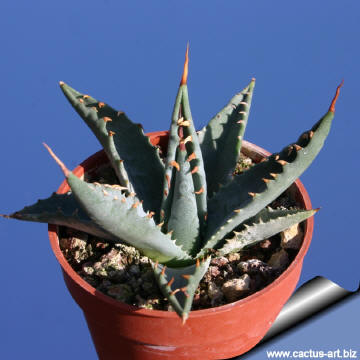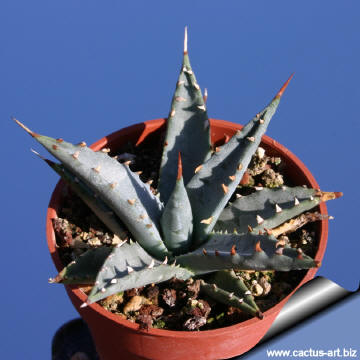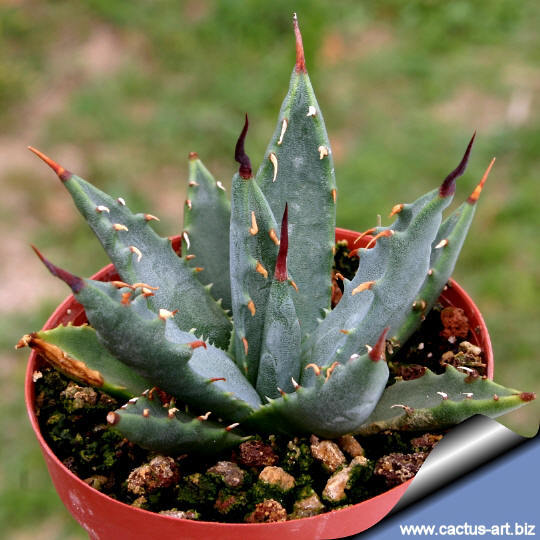|
|
|

Agave utahensis var. nevadensis
Nevada Agave is certainly one of the most ornamental of all the
Agaves. It is also one of the most cold hardy species, especially if
kept dry. Makes an excellent potted specimen.
|
|
Description: Agave utahensis var. nevadensis is one of the
smallest species of Agave. It is
extremely ornamental with small blue-green,
symmetrical rosettes and long,
harmless terminal grass-like spines. Slowly growing up to 15-30 cm tall,
25-30(-60) cm spread. This is the smallest and most cold hardy variety
of A. hutaensis. In contrast to other subspecies it has
broader, bluish green leaves with strong marginal teeth, It suckers
slowly and the suckers tend to be adhered to the mother plant,
eventually forming a large matt of spines where you can't tell which
leaf belongs to which plant.
Leaves: 15–25 × 1.5–3 cm; pale blue-green, linear-laceolate,
straight or falcate, spiked, stiff, convex below, plane or concave
above, ending in a soft, grass-like spine whitish to brown, slender, 4–8
cm long (split usually). The leaves have heavily toothed margins, the
teeth are prominent 4–6 mm long (not very sharp, though).
Flowers: Light yellow, bulbous flower clusters arise along the
stem on short 2-2,5 stalks. The rosette dies after flowering. The
inflorescence varies in style from plant to pant. It may be a spike, a
raceme, or a panicle 2–4 m.
Blooming season: Late winter early summer.
Fruit: Capsules 2-3cm long.
Seeds: Black
2n = 60. |
|
 |
 |
|
Cultivation: Agave
uthaeinsis var. nevadensis is a very cold hardy form of
the species. It is theoretically hardy
to -18°C (or more) particularly when dry. It is
a relative easy-to-grow species. Need a very well-drained, soil.
It grows fairly fast in summer if provided with copious water but
allows to dry thoroughly before watering again. During the winter
months, one should only water enough to keep the leaves from
shrivelling. They do well in full sun or a lightly shaded area. Plants
cultivated outdoors are drought tolerant and takes blasting heat and
full sun. It is a wonderful companion plant for Echinocereus and
Escobaria cacti species. During the
beautiful season it’s good to enrich the soil using a fertilizer rich in
potassium and phosphorous, but poor in nitrogen, because this chemical
element doesn’t help the development of succulent plants, making them
too soft and full of water.
This stylish succulent has long been highlighted in gardening magazines
and television shows. They are great used as feature plants in
Mediterranean and modern style landscapes, pots and containers,
rockeries, embankments and tropical style gardens.
|
|
Advertising
|
|
|
|
|
Family: Agavaceae
Scientific name:
Agave
utahensis Engelm. var. nevadensis Engelm. ex
Greenm. & Roush
In: Ann. Missouri Bot. Gard. 16: 390, plate 32. 1929.
Origin: USA
(California, Nevada)
Habitat: It is native of
dryish, stony calcareous outcrops, slopes and ridges in mountainous
areas and canyons, to the east of the Mojave Desert with desert scrub;
1200-1900 m;
Conservation status: Listed in
CITES appendix 2.
Common Names include: Nevada Agave, Clark Mountain Agave, Dwarf
Agave, Yant, Ivory-spined Agave, American Aloe (it is not an aloe),
Pygmy Agave.
Synonyms:
- Agave nevadensis
(Engelmann ex Greenman & Roush)
- Agave utahensis
subsp. utahensis
- Agave newberryi
- Agave eborispina
- Agave utahensis var.
discretahartmanii
|
|
|
|

Plants may be hardy outdoors in Central Europe
with some protection from moisture.
Propagation:
Suckers or seed.
SUCKERS: Remove the basal suckers (if available) in spring or summer and
let the cuttings dry for a few days before inserting in compost.
SEEDS: Sow at any time of year in a well-aerated compost at a
temperatures of 22-24°C . Stand the pots in water, moisten thoroughly
and drain. Scatter and press lightly the seed onto the top of the
compost. But do not cover the small seeds with compost. Secure a
polythene bag around the pot or cover the container with glass or and
place in a warm shaded place. If possible, germinate in a propagator.
Some seedlings may appear within a week or 10 days others will take
longer. At lower temperatures, germination usually takes considerably
longer. Once germination has taken place, remove gradually the glass or
plastic and move into a good light but not in direct sun. If the young
plants are exposed to too much sun, or the compost dries out, they may
stop growing and often turn red; once they stop, it is often difficult
to persuade them to start growing again. Never let the pots dry out-but
don't saturate them either. A sodden compost is as harmful as a dry one.
TRADITIONAL USES:
-
The plant was used
for food by local Native American peoples. Seed may be ground into
flour. Flower stalk, roasted, & the Root cooked. The heart of the
plant, which is partly below ground, is very rich in saccharine matter
and can be eaten when baked. It is sweet and delicious and can be
dried for future use or soaked in water to produce a flavourful
beverage. Sap from the cut flowering stems is used as syrup. The sap
can also be tapped by boring a hole into the middle of the plant at
the base of the flowering stem. It can also be fermented into
'Mescal', a very potent alcoholic drink!
-
It has very
good fibres which withstand hard wear and are water-resistant, that
are used mainly in brush making, but they are occasionally used for
textiles (can be spun, or made into rope)

 |
|